Rising like a gray winged sailing ship above the Strait of San Juan de Fuca is a house born of the hammering hands of sea-hardened men. It is a vision carried forward by the design of a sailing Captain, who built a house to be ship worthy. This man, this navigator was very, very good because views extend from every room, every window. There is no Victorian trim, no wasted corner, no ‘Schnörkel.” This is a Gothic House — born of wind, sea and clouds. It is of Dungeness air that smells of the sea, air of light, buoyant dance partner to hundreds of sunrises and sunsets.
Today’s is of the woman who nurtures this 140 year old home and of the garden who’s soul can be found sneaking around. In writing this story, I too became intrigued and found myself moving in circles to see what was going on. For in that same intrigue a garden was born. She “wanted to bring along those plants which would say, HEY, thanks for putting me here! IT’S GREAT. I LIKE IT! And people will do the same as they turn the corner. OH WOW! … and there you are.
Few gardens wear their new owners well, and there are fewer owners who treat them lovingly. Both involve listening and accepting in patterns ‘different’ than our own. We find as we braid our own strands, winding before a sea and wind as changing as the sky that flies over the mountains framing the South. Below are found lowland gardens that are just as multi-dimensional! Light bringers that invite the visitor in, to visit, to taste, to explore. Bita’s garden is all the above.
The prevailing winds are Westerly, and like the owners they are clean honest breezes that lighten, brighten and freshen. They whisper of places I would like to be — dreaming of large silvered birds, flying to another world. Illusionary wings that climb the sky. Land bound, garden bound I find on the beach below, grasses seeding to fall-like gold’s. Grain fattened geese crackle to amber air, and fall descends in a green autumnal flash I’ve seen only twice before, both times on this Pacific Coast. A Ravens surprise-hanging claw to sunsets that carry this horizon to a different world; an older one where tricksters flash this summer’s green like a fond farewell.
So old that they no longer have thorns but retaining a protective shield all their own. Weather beaten, deeply lined, their gray barky textures testament to hundreds of sea battles, and their windward leaning and spring profusion, are proud testimony to their survival skills.
Two lovers stand ancient and strong.
Last September, a new friend came to visit. He too, was a Nurseryman, a landscape designer. Bita had been impressed by my recollection of this man and of his East coast nursery. She hoped that he would visit her garden, and looked forward to hearing his observations. These were his words as well as my own. Upon seeing the Hawthorns, Leo remarked, “It’s too bad the one on the right couldn’t be pulled just a little to the side. Trees should frame a house, not block it.” He’s right. But he too was struck by the strength and sparing honesty held in the limbs of the hawthorns. Leo chose his words very carefully.
Silence can sometimes be the warmest of compliments, and often the most effective. The view over these Straits reminded Leo of Cape Cod of the horizons that are shared by all such seaside gardens. They hold views that extend far beyond our normal dimensions, pathways where the past, present and future merge at a vanishing point. This coast, and this garden remain deeply imbued with the spirits of an older and wiser culture, one that strongly respected its elders, and where seeking anothers wisdom was willingly sought. It was a time where dream worlds were as real and as important as the world clothed in daylight and where one could belong in both.
It would be to such a garden that I would be drawn to. I remember Bita telling me that she never hesitates to change things that aren’t working. “Because I sincerely believe that when plants don’t do so well, it isn’t the soil, it isn’t what you give them, it’s simply you don’t have them in the proper place, in the right companionship.” I would take note of her words and observe how this garden, like her, is designed to be a full circle, always moving to the light — like the dance of the bee. Alton, her husband, would tell me “She never stays in the same place long. She never gets lined up or stays in one place. Her garden is a dance of movement, more than the work — the facet everyone sees. In seeing only the work they miss the dance.”
Sometimes I find her stilled and perched on her garden porch, silent and reflective, and like those earlier Elders, wisdoms like windblown seed would radiate. A Gift to those she trusts very much. In such sharing our own warmer daylight freed. A harvest of giving, found in gardens strong enough to value receiving in equal measure.
These are autumnal recollections of the words of another friend who wrote in the Shaman’s Garden “I am strong enough to receive what is mine, for it is only through receiving that I may comprehend the wholeness of giving.” These summer words well reflect the summer’s intensity of this garden.
Earlier this year I was asked. “If you died tomorrow and found yourself perched on a cloud looking down. Ask yourself, did I get what I came for?” Bita has her answer to this question. Answers sometimes come from good questions and from good teachers. For Bita, they were the influences of painters like Braque; Cubists taught her the importance of textures, color and juxtaposition of forms, and how things fit together. “Not in a monotonous, interlocking that is boring, but in a multiplicity that gives each plant, or each square, each color spot a chance to speak for itself, and yet fits in the whole. It’s a wonderful idea.
Sometimes it is hard. One doesn’t always fully enjoy a teachers painting or influence. You’re so distracted n the seeking of his answers; you miss the process. But then sit back and never mind the answers. Feel it!
Is it a great painting or not? That is something else again!
In life we search for rewards in the finished canvas, more than in the learning process. “In the looking, we often forget that wholeness and richness is derived not from the results, but from the workability of a beautiful thing, gardening — with the plants.” Too many garden only with their heads. They garden like the 80’s power lunch, talking while their eyes keep straying over the greater scene, afraid that for a momentary lapse they may miss something. In so doing they already have.
Bita and Alton garden with their hearts, untrammeled by worries of valuations — and find equal satisfaction in the middle ground of life. That is not to say that these two don’t have immense pride in all of their accomplishments. Bita would be the first to say; “One sows with what one has and invests oneself in life as strongly as one can.” As for the rest — In gardens as in life some seeds will flower, others not. Gardens are an act of faith, and of hope, and their long-term foundations are secured in the continuing strength and empowerment of dreams.
We infuse strong gardens with powerful ‘green lines’ visions that speak of love and acceptance, and of care and respect given for differences. Wouldn’t it be nice if gardens were built less of projecting, but more of protecting and finding in the sowing — the more we create, the more flows back. As the blood that sustains, many conversations take place beneath the surface. There is found a flow of resonance’s built of morning silences when the gardener isn’t even there. An undercurrent that is a green ‘ocean ground’ of daily renewal, ready to greet those willing to surrender to its depths.
A surrendering to that middle place, often hard to do — most of us garden too busily. The deeper tides, like those found in this garden are very rarely encountered in life; and perhaps, because I am not there myself, I find myself uncomfortable in this garden of condensed thought. Sometimes it is difficult being in two places at once. It is equally hard moving from one world to another.
Sometimes, even the same perspectives prove to be entirely different. What are colors, but a choleric change from the garden at night. The grays and shades not seen for the sun seem reflective of other life focusings we are reluctant to zoom in on. The value of editing, pruning if you will.
Mark Tobey, Bita’s teacher, used to say, “I’d do a painting and I’d look at it, and I’ see one thing and I’d cut that out and just discard the rest, instead of trying to make everything else work with the one thing. And then he’d work from there instead of trying to bring it all up to the one spot you focused on.
In gardens, as in life, some seeds will flower, others not. Gardens are an act of faith, and their long-term foundations are secured in the continuing strength and empowerment of dreams.
Bita felt complemented that Leo and I actually moved all around and through the area. “That is the way I see it … that is the way I see alpine plants in the high county.” Like the High country, Bita’s garden is one of strong friendships, both old and new. It is one of good conversations, investments and nurturing, with allowances for wild things to experiment freely. Sometimes to struggle, intuiting much — but allowing the process to flow.”No matter how small the garden, if you look around, turn your head, walk around — there is always another new experience. You move on. Like a person, if you can get it all in five or ten minutes, or even ah hour, there’s not much there. You’ve got to be able to come back again and again, and continue to discover. That is the way is should be with people.
As Leo observed, “Ultimately all gardens are correct, for they are of the owners’ and of no one else. One should never be overly critical of someone else’s preferences — nor should gardens be compared to others.” Remembering this late September visit, Leo and I were centered within this garden, without analyzing but simply admiring the complexities found within.
The entrance of the rock garden reflects Bita’s soul. Like her, it is born of many rich textures; strong and linear like the dwarf conifers she loves, yet slippery like the quicksilver overlap of Antennarias blending with the Vancouverii’s and Globularias. Well braided weavings and intermixtures of investments and gifts from friends; they are invitations to visit, to stroll, to stop, and to observe —
How this entry garden pushes us forward to a carefully composed centerfold door, an opening to trees planted by earlier owners. A ‘Hildegardian’ world underlined with the wild greens of natives and latecomer perennials. It is a coastal oasis of Hellebores and species Rhododendrons, a pathway interlude of little creatures, like green under linings to Natures most optimistic overflow. Small hypnotic intimacies, so minute that one needs to hunker down to observe those nesting within.
Sometimes even blocked by unexpected summer outcroppings, like these south facing Calendulas. Oranges, so strong, so bright, so intense, they are the pumpkin maitre’ d, the stop signs to this visit, pushing us to redirect our footsteps. Perhaps, this is their purpose. Cholerics, with a sense of humor, they invite us to look at things differently. We laugh, and then return to pathways more intimate, more proper.
Magic is found in the interplay of softer tones. The eye prefers to travel like the bee, flitting from one form, one color to another, gathering the tasting of blossoms that invite harmony. A drowning in this late September light that falls honey-like and amber warm, like a swarming of autumn leaves upon a garden that invites a shifting of light.
Fall brings the realization that many garden goals may not be met before winter snows. Bita says, “You don’t carry over. You don’t get so smart that you outsmart yourself, even by carrying over something that was successful. Because then, you’re not really looking at where you are, and that is new involvement. That is what growing older means.”
“Going through life is a flow of various stages. Each one builds on the other with no lament that you don’t have that which looked so beautiful, and Oh, I wish I still had that. You enjoyed it. Listen, Herb, This Is Really Important!”
Fall shifts focus. Even as winter approaches, there is no easy surrender. Even now Calendulas and Cosmos give forth a fiery blaze that challenges the autumn bite of Parrotia’s and Enkianthus that see red. The leaves, linger, yet slowly yield to the approach of their destiny. Deprived of green, show their true colors, “they more or less loosen from within. And, only in the fall can we glimpse the full growth of the branches … growth hidden by the leaves of summer.”
Old gardens that survive have done so because they are hard-worked gardens, and differences may yet arise, blendings that mesh with each other slowly and more subtly. Plants that may appear delicate, but were chosen well, and hold firmly in all the wind and rains that visit this Northwest corner. They say to the coming winter of ice and snow. I am stronger than I look! I am also hard work.
When Alton and Bita first saw this garden, “Everything was weeds … there were seed pods everywhere. That is when she knew that this was a garden of considerable richness. That’s what made me do it” She had seen the work, and remembered saying, “Don’t do it. It’s too much!” She told me that was hard for her to admit. “But when I saw the richness from all these seedpods and all these things going on I said to myself, you cannot come in with any kind of weed killers, because, you will never know some of the things yet to come up.” And that is the wholeness, the enduring legacy of this garden.
This philosophy nurtures their garden. New things are born every year (legacies of the heart) surprises that were not there the year before. What do these plants do? When do they decide its time to make a re-appearance? Some of it speaks to love and to daring. It also speaks to the warmth of May, for in spring as in summer there fell many chance seedlings. They moved on and took root in the most unexpected of corners.
A friend writes, “Why do they stray to locations where the sun is more hostile?” Birthing s are easy, but they can easily be lost or misplaced in life. “The gardener with a heart finds them; lifts them gently up — always careful to try to find them a better place. Hearts that feel pity when these plants can’t hide from the sun.” (Written by a lady with the name of Shade.) Sometimes, they adapt and prove a surprise to one and all. Often, they survive, and in that adapting pass on a new hardiness to seedlings yet to come. Are they melancholics reaching out to the sun — to their brighter fulfillment — can we ever know?
Perhaps life’s seedlings need this testing. Bita loves Gaultherias and grows a great many of them. She challenges them. “Basically they don’t like full sun, they really need some shade, but I would plant them North, South, East, West in all kinds of different locations. It was surprising how some just sort of existed and others increased richly, and I got the greatest joy out of finding that out.” “You see, that’s experimentation and that’s not going along with the prescribed rules.” The here is where it shoud be’ums. Her whole garden holds surprises, combinations and placements I would never have tried.
Placements are too often made of patterns captured from books rather than from the gardeners own sorcerer’s trowel, or natures own. Sometimes a plant just needs a walking around the corner, to moister soil’s, or climate zones lapping over themselves. It is in these magical happenings that we find newborn forms, not of one or the other. ‘Speciation’s.’ as Bita says.
“You bet there will be surprises, one cannot even be certain how different plants will react with others.” It’s like people, I can handle you singly, like this, but I don’t know if I could handle you in a crowed. I might think GEE, get out of the way. You’re messing up the whole thing! This is the same in a garden. You think you know your plants. Basically you know variations of species and different forms. But when you intermingle with the other plants, then they’re not doing what you think they should be doing.
And that’s where you get into the whole thing … (I impolitely interrupt with) “Who you would invite into your garden — was this a hint?” I remember bouncing into one of her summer afternoons. She was on her porch, and she turned to close the door. “To keep the varmints out.”
The arrival of a new creation does not always fit comfortably. Sometimes though, we take notice. The miniature conifer, Abies lasiocarpa ‘Duflon,’ discovered by Alton and Bita, high in the Olympics, is now propagated and nestled securely in this seaside garden. Its own children are housed in many other gardens, thanks to the keen eyes and observing hearts of these two people. Thanks as well to Ed Lohbrunner who took cuttings from their plant. He took five. All rooted! That winter the parent plant died. These are the miracles the Steward above bestows upon those who care.
Like the two Hawthorns, Bita and Alton have managed to infuse their own thread of green, to this garden, to a history they are now part of. They always knew it would not come easily, or quickly, but these two are of an older generation, willing to work hard and to invest their souls fully.
Alton, told me, “Like Bita, I enjoy the garden because of the plants I work with — that I talk to– and get answers to even.” He went on to say that he couldn’t think of an example where he’s seen Bita unhappy in the garden, “Even when she’s not feeling very well. The garden is her tonic.” I felt that too, but from a different view. The late 80’s were quite dark for me, and I told them that there were times I might have died, if it hadn’t been for my plants. It was like they were saying, ‘We need you to keep us alive,’ but all the time, I was sucking their green juices into me, and they were keeping me alive!
Bita knew me then and commented that she had hoped that I could work out of it, because that negativity does not go with gardening. Gardeners, no matter how thick or deep the glumming might be, should be able to overcome it sufficiently to get back into the garden and give it another chance. “It is the same with most musicians and artists. Even when unhappy or suffering, they were not unhappy to work, not unhappy to work with their tools, and let their energies, their sadness out. For theirs too is a struggle to communicate. Too often they are compared to others, looked at and heard with a critical and comparing eye and ear rather than enjoyed.
In knowing these two, I have become part of this garden. They have encouraged this younger hawthorn to get moving. “Hey, I’m part of a garden now. I’ve got to get going now! I’ve got to get going here — I can’t stay spindly like I was.” Gardens are not meant to be autobiographies to self-importance, nor solitudes as escapes from realities. Gardens can be hard cutting beds, sometimes meant to birth new challenges. The rewards — the gifts — are Wonderment, and finding oneself, a little bit at a time. A firmer grounding in this reciprocal creation, a seeding of nurturings that return … when finally, we too mature as fully as our garden, the achievement of knowing our heart as well as our garden.
We don’t always know why someone turns on to a garden, be it just a little corner, or the whole. Some visitors like Leo may choose to use few words but in their silence they have absorbed what these two have created. Gardens like theirs do no come easy, affirmations, not for egos, nor derived for results, but simply for “the workability of a beautiful thing … a garden with plants.”
Lessons, of investments and free giving movements that two dissimilar people can give each other; like their garden they are of hard and enduring construction. Their spirit, their mix will endure. Today as I exit this garden I know that someone 140 years from now will see what they have done and be touched by it as well. Not a bad answer to… “Did you get what you came down here for?” Bita and Alton, might just be able to say
“Ya, I think we did!”
As this late September cools, I walk in fog- wraithed grasses and feel a chill suspended in the air, a warning of winter soon to come. The fog is a feminine prescience that wraps her slender fingers around this house, over this garden, into my soul. A possessiveness waiting to put this garden to rest, fall’s alchemy of light has begun to fade.
The summer of deadheading is over. The fuss abandoned under the drift of autumn leaves. This garden-in-fall invites new revelations. It has a soul born of movement, like the elementals wind and sea.
Sunlight surrenders to a leonine tawnyness, a stretching somnolence that is tasted. The plants feel it, as do I – warning triggers, that this ‘greening’ needs a rest. This evening’s hoarfrost forebodes winter and Northern Spirits ready to avalanche their way south.
Bita’s garden was summer pruned, like the Enkianthus, revealing torsos and shapes Leo and I never knew they had. This woman knows how to seek out these hidden souls. Hard honest pruning, (be they of shears, or of words) are necessary tools in this summer of exuberance. The hawthorns survived the elemental winds because they were never allowed to get too bushy or thick, so they would blow over. I questioned the seeming lack of perennial under planting. They’re lonely.
Only bulbs and natives were planted, for “to plant things that have to have water would get them too excited, would get them growing. They would get too heavy, too out of scale, too vulnerable to the wind.” This is why we are friends. Bita prunes well, gardens hard, and by her pruning, new forms are given birth. The gift is in the knowing of the proper time, early enough for second growth to harden off fully and provide protection against winter’s cold. Nature teaches gardens to hold on tightly to life. Bita’s actions teach that sometimes we have to be ruthless in warmer seasons that may still be bringing flowers. Late summer prunings stimulate the underlying roots to delve more deeply into the soil. They provide a strong lesson to the rest of us who would walk into this winter season unprepared.
Sometimes we ignore, or simply don’t catch up to the things we really need to be doing. It may just be the normal catch basin of daily living, to the job, to the other responsibilities. Always to others! We need the distancing we can find in the garden…. to catch up with ourselves. Back to the hawthorns. I always liked to think that the one on the right buried a bit ahead, wanting to pull the other to enter before the seasons ends.
I think these where the flowers he admired most. I explained that it was the grave of their best friend’s dog. Leo said nothing, but in that moment he understood the owners of this home better than
I who had visited on the day they buried Inge. In familiarity, I would have walked on by. Leo traveled with an unhurried and different eye, expecting nothing, thereby seeing things I did not.
Sharing places with friends whose eyes are open to different windows is a special adventure. Like Bita and Alton who helped wake new horizons, new depths and perceptions in my soul, good gardens are the foundations of new relationships — sometimes our own.
I told Bita that I may yet go in any direction. She replied, “You may go in several directions if you meet a strong enough person.” … and there I am.
Schnörtel – as opposed to snorkel. German for ornaments, flourishes. I always mispronounced it as Schnörkel.
(The McAlmond House was built in 1861 by Captain Elijah H. McAlmond. The house stands on the bluffs of Dungeness near Sequim, WA.. The home remained in the McAlmond family until the mid 1900s, when the last remaining property was put up for sale. Bita and Alton Duflone were the last caregivers of the property and passed away just a few years ago. The McAlmond House is on the Washington State Register of Historic Places. and has just been sold.



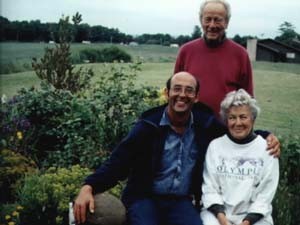
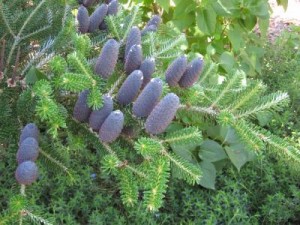
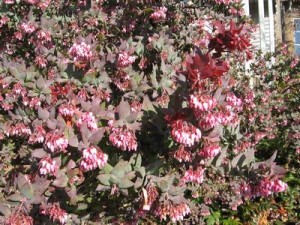


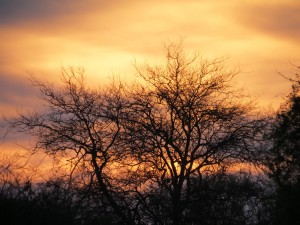


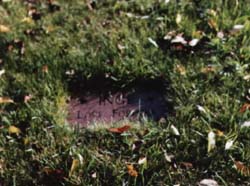
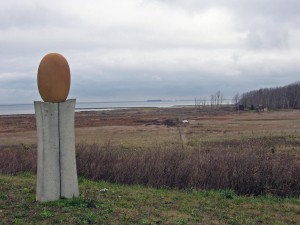
Dear Helian, if it’s OK that I call you that
This is, quite frankly, moving. Just wanted to let you know,
Tom (HINDE97)
Thank you for the website commentary,
That was very kind. Sadly too few of us take the time to scratch the surface of people we know but don’t.
I personally never got to know my parents and that ‘karma’ now extends to my own children.
Forward this link to a song I value much…. and I DO look and listen to ‘old’ folks before their stories disappear. Often times their own children don’t even care. It is a very sad song, but very true if you really listen to the lyrics.
http://www.metrolyrics.com/hello-in-there-lyrics-john-prine.html
MUTE the damn commentaries!